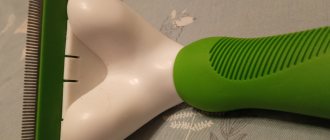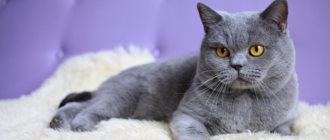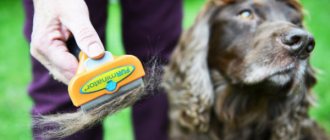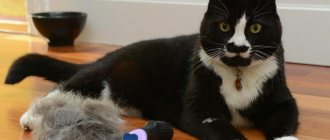The Furminator for cats is loved by many owners of mustachioed and tabby cats. Every owner wants to get rid of annoying animal hair in their apartment. It can cause allergies in humans, and intestinal disorders in cats if it enters the body. The problem becomes even greater if several pets live in the house.
In this situation, a furminator comb becomes a real salvation. Using the device, you can remove almost all fallen hairs from your pet’s undercoat and prevent them from spreading throughout the house.
What is it - a furminator for cats
This invention was invented by a group of American specialists consisting of groomers, breeders and veterinarians. The device is not many years old, but it has managed to enter the lives of cat owners as a necessary item in their grooming arsenal.
The furminator looks like a comb with a handle. The main role here is given to the metal blade, which has an unusual sharpening. It allows you to capture hairs from the very depths of the undercoat and thereby remove almost all lost hair. The device body is made of durable plastic. The holder has an anti-slip rubber cover or rubberized inserts.
Undoubted advantages
When buying a furminator for cats, you need to understand what it is and how it differs from other accessories and combs. This will help you make the right choice. Compared to a slicker comb, the Furminator has several advantages in the fight against hair loss.
So, why do you need a furminator for cats with such a variety of grooming accessories:
- It removes dead inner undercoat. Conventional combs remove only the top layers and do not reach the undercoat, which can accumulate for a long time, becoming entangled in the long pile. The Furminator helps remove the hard-to-reach inner layer that can be so difficult to comb out.
- Does not spoil the structure of the coat. Despite the metal teeth, the Furminator does not damage the fragile cat skin and fur structure. It gently removes undercoat without harming the cat.
- Prevents the formation of tangles. The inner undercoat is difficult to comb out with combs, and in long-haired breeds this can cause increased formation of tangles.
- The cat eats less of its fur. When licking, a cat swallows a lot of hairs, and during the molting period their number doubles. This negatively affects the pet's gastrointestinal tract and can cause intestinal obstruction. By removing the inner undercoat with a Furminator, the owner helps the cat cope with excess fur and improve its health.
- During the process itself, the grease is evenly distributed. As a result, owners note that the animals' fur becomes shinier and smoother. She looks healthy and well-groomed, like after a trip to the groomer.
Perhaps one of the advantages is indirectly the ability of the furminator to keep the house clean. The less the cat sheds, the less often you need to collect hair throughout the house.
Operating principle
To understand the principle of operation of a special comb, it is enough to imagine a modern trimmer. Only the furminator does not cut the hairs, but lifts them so as to capture the small pile from the animal’s undercoat. The owner needs to remove the hairballs from the device and throw it in the trash. At the same time, living hairs remain absolutely intact and unharmed due to the correct arrangement of the teeth. The procedure is not complicated, but it does require a little skill and time.
To remove almost all excess hair from an animal (up to 90%), it is necessary to carry out 3-4 procedures, and sometimes even less, during the molting period.
The device is durable because its blades do not bend or break, as happens when using a regular cat brush. The animal's skin is not injured. The owners assure that their pets tolerate the procedure well - for them it is absolutely painless.
Why care for your cat's fur?
Regular brushing sessions clean the animal's fur of dirt and dander, remove dead hair, prevent the fibers from getting tangled and reduce the number of hairballs in the cat's stomach.
By combing the animal, you give it a massage. This improves blood circulation in the upper layers of the skin, which leads to improved coat quality. During the hot season, brushing helps prevent heatstroke.
Grooming helps keep your home clean while your pet is shedding. If you don't brush out a shedding cat, dead hairs will fly around the apartment, accumulating on the floor, carpeting, furniture and your clothes.
Types of instruments
There are several models of furminators, and it is best to choose the best option taking into account the breed, health status, coat and the amount of lint that falls out. Cats should be combed with a high-quality furminator, so as not to spoil the animal’s coat. There are only three main types of tools.
For long-haired individuals
For cats with long hair, use a furminator with long teeth located at a large distance from each other. This is due to the fact that in long hair the undercoat gets tangled faster and much more strongly. The process causes the formation of tangles, which subsequently become impossible to comb. Manufacturers take into account the age and weight of the cat, and also produce special models for kittens.
The product has a special designation – “Large”, which indicates that the model is intended for adult cats with long hair. There are also two subspecies: for cats with hair lengths up to 10 cm and for those individuals whose hair length exceeds 12.5 cm.
For short-haired individuals
For cats with short hair, there are three modifications, including the weight of the animal. These modifications are designated as “Small” (small), “X-Small” (very small) and “Medium”.
Depending on the hardness of the cat's hair, there are varieties for hard or printed (soft, plush) coats. A consultant at a pet store will help you choose the appropriate model.
According to technical qualities, there are “Classic” and “Deluxe” levels. When choosing between these types, you will notice differences in the quality of the material from which the handle is made, and the presence on the Deluxe model of a button for automatically cleaning the comb from combed hairs.
For certain breeds
For British and Scottish Shorthair cats there is a special furminator suitable specifically for this breed. It is designed for the characteristic plush fur. The model is selected according to the weight and size of the cat.
For Abyssinian cats, combs are suitable that go deeper into the coat to comb out the most inaccessible layers of the undercoat. These are usually 4 cm wide ridges.
Gradation by size
The labeling of values varies among different manufacturers, but generally comes down to 4 categories:
- small – (Small, Mini);
- medium (Medium, Midi);
- large (Large, Maxi);
- universal – 3(4) in 1.
The most compact option is suitable for small animals and kittens. The width of the comb of the device does not exceed 3.3 centimeters. For adult fluffies weighing 5-6 kilograms, you need to choose a furminator with a blade width of 4.5 to 7 centimeters. There are also offers for owners of large specimens: the blade width of the “Maxi” model is 10 centimeters.
Universal models are sold complete with several attachments. This allows you to change one blade to another depending on the breed of your pet. Typically, such things are used by professional groomers or owners of several animals.
Slicker comb: the most popular
In order to comb out dead fluff without affecting the strong guard fibers, you will need a so-called slicker, or slicker.
The peculiarity of the slicker is in its teeth. They are metal, thin, with a characteristic bend. Depending on the quality of your pet’s coat, you need to choose a slicker brush: the thicker and longer the coat, the longer and more frequent its teeth.
You should not try to deal with matted hair using a slicker. It is intended only for the care of healthy hair, previously combed with a wide-tooth comb.
When your cat sheds, refrain from brushing her coat with a slicker every day. Twice a week will be enough. More frequent use will turn your fluffy beauty into a pitiful, shabby creature. After the shedding period ends, use this useful tool once a week.
Despite the popularity of the slicker, it is only one of many tools needed to care for your pet.
Criterias of choice
By comparing all the available types of tools with the characteristics of your pet, you can confidently make a choice. What you need to determine before purchasing:
- pet's hair length - it is better to measure with a ruler;
- weight and dimensions - if in doubt, choose a furminator with a narrower blade to reach the lint in hard-to-reach places;
- how much money are you willing to spend - the Deluxe class costs one and a half times more, but it is incomparably more convenient.
Pay attention to the country of origin. Do not buy questionable products - they may be of poor quality and therefore dangerous for your pet.
What to choose: a comb or a comb
Both the brush and the comb are equally important for caring for your pet’s fur. The difference between them is that the scratcher is attached to the wall, door frame, table leg, that is, in the place where the cat often rubs its face or back. A comb is an object that the owner will use to specifically comb out his pet’s fur.
These devices should be used together, since with the help of a comb you can comb the cat in those places where it cannot reach, and with the help of a scratcher the animal can rub itself in those places where it wants it.
Disadvantages and contraindications
Before using a furminator for cats, you need to remember that this is a device that has contraindications and some disadvantages. It is best to consult a professional before using it on your pet. In some cases it can cause harm:
- The Furminator should not be used if the cat has lesions on the skin, as well as subcutaneous mites, dermatitis or fungal infections.
- Some “hairless” breeds do not need to be combed with a furminator (Canadian Sphynx, Don Sphynx, Peterbald, Ukrainian Levkoy, elf and others).
- In addition to short-haired breeds, there are breeds for which combing with a furminator is contraindicated due to the almost complete or complete absence of undercoat (Burmese, Laperm, Devon Rex, Cornish Rex, Oriental and others).
If any doubt arises, you should consult a specialist. Damage to a cat's skin takes a long time and is difficult to treat, so it is better to protect her from this trouble.
Brushing dogs with a furminator: pros and cons
The advantages of the device include its ability to significantly facilitate and speed up the combing of dead undercoat.
- The device removes fluff and dead hair.
- Reduces molting period by 90%.
- Does not cause pain when exposed.
- Helps remove tangles.
- Dirt, dust and even parasites are also removed with dead fur.
- Brushing distributes the oil lubricant throughout the dog's body, protecting the skin from harmful environmental influences.
The disadvantage of the furminator is that it costs more than a comb.
- In addition, low quality fakes are often found. Counterfeit tools break quickly and can damage the dog's epidermis.
- If your dog has a lot of tangles, you must first remove them with your hands.
- The Furminator is not suitable for all coat types. For example, it is not suitable if the dog has no undercoat (blue terrier, bichon frize, Portuguese water dog).
- Do not use the tool when the animal has skin wounds or injuries.
The tool is not suitable for all dogs. For example:
- If the dog has silky hair (lapdog, shih tzu, Yorkshire terrier), it is combed out with a comb and brush.
- If the coat is hard (Airedale Terrier, Schnauzer, Irish Terrier, Spaniel) or curled (Commander, Puli), then the Furminator is also not suitable.
- Pets with very short hair or hairless dogs (Peruvian Hairless Dog, Chinese Crested Dog) do not require a Furminator.
How to use a furminator for cats
Before using the device, you need to study it thoroughly: be sure to read the instructions. It is also recommended to check the serviceability of the device - inspect it from all sides. There should be no burrs on the blade.
Treatment frequency
It is especially useful to use the device during molting animals. At this time, you need to comb the fluffy often - every 1-2 days. Later, when the acute period of hair loss has passed, treatment with a furminator can be carried out less frequently - about once a month.
In summer, the procedure will be needed a little more often: a clean coat and the absence of excess hair will allow the animal to maintain normal heat exchange on hot days. Focus on the pet's condition and its comfort.
Algorithm of actions
Consider where you will place the animal - ideally it should be a table, couch or something similar covered with a non-slip material. It is advisable to have a light source and a wool basket nearby. Don't forget to prepare your pet's favorite toy - he may need to be distracted and calmed, because not all cats tolerate hygiene procedures well.
The animal's skin and fur must first be examined. Under no circumstances should you comb out if there are wounds, cuts or pustules. Postpone the procedure until the sores heal.
A long-haired cat must first be bathed to remove dirt from the hairs. Clean wool is the key to the success of the operation. The pet needs to be dried a little, combed and checked to ensure there are no tangled hairs or tangles. After this, you can start combing.
It is necessary to work with the furminator only in the direction of hair growth. Movements must be careful. Pressure and pressure on the skin should not be allowed. Sensitive areas (stomach, groin) should be treated with extreme caution - carelessness can cause pain to the animal and cause fear of the procedure.
For the first time, in order not to experience anxiety, it is better to go to a groomer and, under his guidance, carry out combing. You can also invite a specialist to your home.
Features of combing a cat depending on the breed
Cats of different breeds require special care. Of course, in many respects the rules for combing are determined by the type of fur and its length. However, there are some nuances to this procedure, taking into account the specific breed of cat.
Grooming a Scottish cat
Scottish representatives need to be combed first along the growth of the fur, then in the opposite direction, which will eliminate the possibility of damage to the undercoat.
To care for the coat, you will need a comb with sparse teeth. After combing with this accessory, we move on to using a furminator or a brush with natural bristles.
Grooming a British cat
British cats have a dense undercoat. During the winter season, combing the fur is done at least 1-2 times a week. Such care will prevent the formation of tangles.
To comb your British hair, you can use a comb with rounded metal teeth or densely set long ones. After the procedure, dead hairs can be removed with a damp hand by stroking.
Representatives of this breed should not be brushed with a slicker brush, as this will spoil the attractiveness of the undercoat.
Many cats love brushing their fur. If your pet is categorically against such attention, accustom him gradually, rewarding him with his favorite treat after combing. Over time, the cat will get used to it and stop resisting.
Rules for use and care of the instrument
When you first meet it, it becomes obvious that a furminator for cats is a device that combines different materials. But avoiding this does not become difficult. The simplest rules:
- There should be no foreign objects in the cat's fur - specks and tangles; they must be removed first.
- The device is used only on clean fur, so if the cat gets dirty, it should be washed and dried first.
- After combing is completed, the furminator should be cleaned of hair and the blades should be covered with a protective cap.
With proper use and care, the tool will last for many years (from 5 to 10 years). The main thing is to strictly follow the rules of use.
Mitten: the easiest to use
If your pet doesn't like combs and slickers, try using another tool popular among cat owners - a rubber mitten.
Short or long teeth, located at different frequencies on the surface of the mitten, perfectly massage the skin of the animal. Thanks to this, blood circulation improves, the hair follicles are strengthened, and the coat becomes healthy and shiny. Cats love this massage very much. It can be carried out both on dry wool and during water procedures. Of course, one mitten cannot replace a whole set of combs, combs and brushes, but if your pet categorically objects to the use of other tools, it is still better than nothing.
Review of popular models
Among the many models, the main thing is to choose the most suitable furminator for cats, because this device will serve for many years. It should be convenient for the owner and safe for the pet.
Manufacturers and models
The most common manufacturer of furminators for cats is FURminator, because it is the first company to produce such accessories for cats and dogs.
There are other models from various manufacturers:
- Hello PET trimmer brush;
- FoOlee One Medium trimmer brush;
- furminator for cats and dogs of different sizes PetComb;
- Xiaomi Pawbby Anti-Hair Cutter Comb;
- furminator DeLIGHT;
- furminator for dogs and cats TRIXIE;
- furminator for cats Zolux.
It is better to select a model in accordance with the breed and characteristics of the pet. If you are doing this for the first time, enlist the support of experienced friends or trust a consultant at a veterinary pharmacy.
How to avoid buying counterfeits
If you buy a furminator for cats on the Internet, it is not a fact that it will be a successful purchase. The photo may show one product, but they will bring you a completely different one.
To avoid buying a fake, it is better to buy a furminator at a veterinary pharmacy or specialized pet stores. You should always check the packaging, manufacturer and availability of the warranty card.
The Furminator is a great product for owners of short-haired and long-haired cats. It saves during heavy molting and preserves the beauty and health of the pet.
Do you like the article? 225
Rating of the best furminators
| Nomination | place | Name of product | price |
| The best furminators for dogs | 1 | Furminator FURFLEX Medium M | 1759 ₽ |
| 2 | Hello Pet small (43 teeth) | 960 ₽ | |
| 3 | Furminator Short Hair Tool Toy Dog | 1590 ₽ | |
| 4 | Furminator for dogs “Trixie”, 8 x 14 cm | 1300 ₽ | |
| The best furminators for cats | 1 | Furminator Cat Small for cats with 2 combs 4.5 cm | 1450 ₽ |
| 2 | Furminator Long Hair Large Cat | 1930 ₽ | |
| 3 | Furminator Foolee One XS 3.1 | 1150 ₽ |











